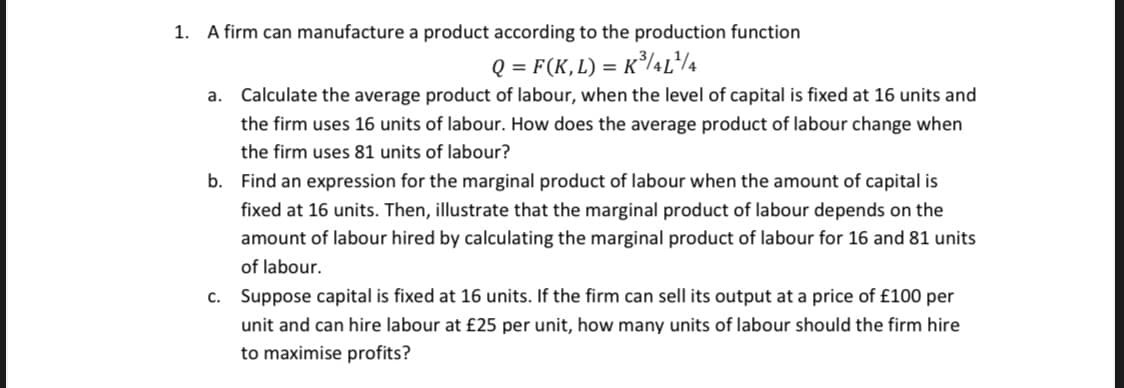1. A firm can manufacture a product according to the production function Q = F(K, L) = K³/4L¹/4 a. Calculate the average product of labour, when the level of capital is fixed at 16 units and the firm uses 16 units of labour. How does the average product of labour change when the firm uses 81 units of labour? b. Find an expression for the marginal product of labour when the amount of capital is fixed at 16 units. Then, illustrate that the marginal product of labour depends on the amount of labour hired by calculating the marginal product of labour for 16 and 81 units of labour. c. Suppose capital is fixed at 16 units. If the firm can sell its output at a price of £100 per unit and can hire labour at £25 per unit, how many units of labour should the firm hire to maximise profits?
1. A firm can manufacture a product according to the production function Q = F(K, L) = K³/4L¹/4 a. Calculate the average product of labour, when the level of capital is fixed at 16 units and the firm uses 16 units of labour. How does the average product of labour change when the firm uses 81 units of labour? b. Find an expression for the marginal product of labour when the amount of capital is fixed at 16 units. Then, illustrate that the marginal product of labour depends on the amount of labour hired by calculating the marginal product of labour for 16 and 81 units of labour. c. Suppose capital is fixed at 16 units. If the firm can sell its output at a price of £100 per unit and can hire labour at £25 per unit, how many units of labour should the firm hire to maximise profits?
Chapter11: The Firm: Production And Costs
Section: Chapter Questions
Problem 8P
Related questions
Question

Transcribed Image Text:1. A firm can manufacture a product according to the production function
Q = F(K,L) = K³/4L¹/4
a. Calculate the average product of labour, when the level of capital is fixed at 16 units and
the firm uses 16 units of labour. How does the average product of labour change when
the firm uses 81 units of labour?
b. Find an expression for the marginal product of labour when the amount of capital is
fixed at 16 units. Then, illustrate that the marginal product of labour depends on the
amount of labour hired by calculating the marginal product of labour for 16 and 81 units
of labour.
c. Suppose capital is fixed at 16 units. If the firm can sell its output at a price of £100 per
unit and can hire labour at £25 per unit, how many units of labour should the firm hire
to maximise profits?
Expert Solution
This question has been solved!
Explore an expertly crafted, step-by-step solution for a thorough understanding of key concepts.
Step by step
Solved in 4 steps

Knowledge Booster
Learn more about
Need a deep-dive on the concept behind this application? Look no further. Learn more about this topic, economics and related others by exploring similar questions and additional content below.Recommended textbooks for you

Exploring Economics
Economics
ISBN:
9781544336329
Author:
Robert L. Sexton
Publisher:
SAGE Publications, Inc

Managerial Economics: Applications, Strategies an…
Economics
ISBN:
9781305506381
Author:
James R. McGuigan, R. Charles Moyer, Frederick H.deB. Harris
Publisher:
Cengage Learning


Exploring Economics
Economics
ISBN:
9781544336329
Author:
Robert L. Sexton
Publisher:
SAGE Publications, Inc

Managerial Economics: Applications, Strategies an…
Economics
ISBN:
9781305506381
Author:
James R. McGuigan, R. Charles Moyer, Frederick H.deB. Harris
Publisher:
Cengage Learning




Microeconomics: Principles & Policy
Economics
ISBN:
9781337794992
Author:
William J. Baumol, Alan S. Blinder, John L. Solow
Publisher:
Cengage Learning